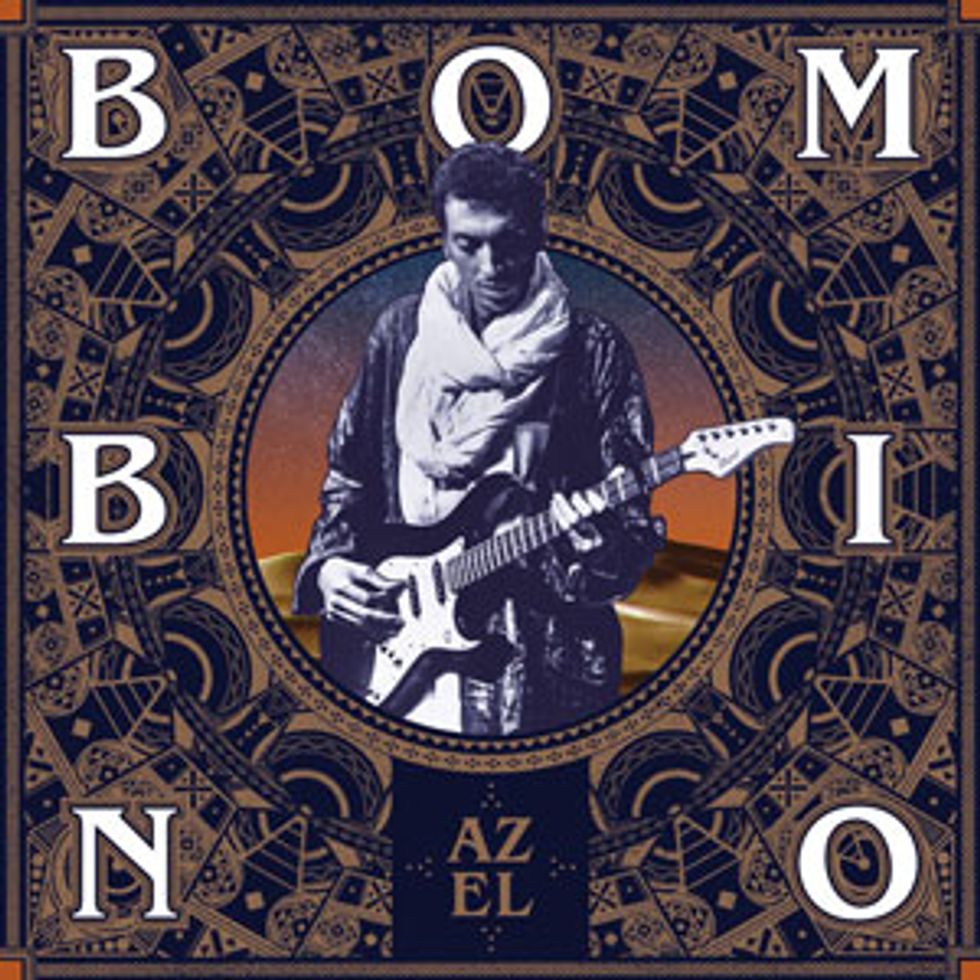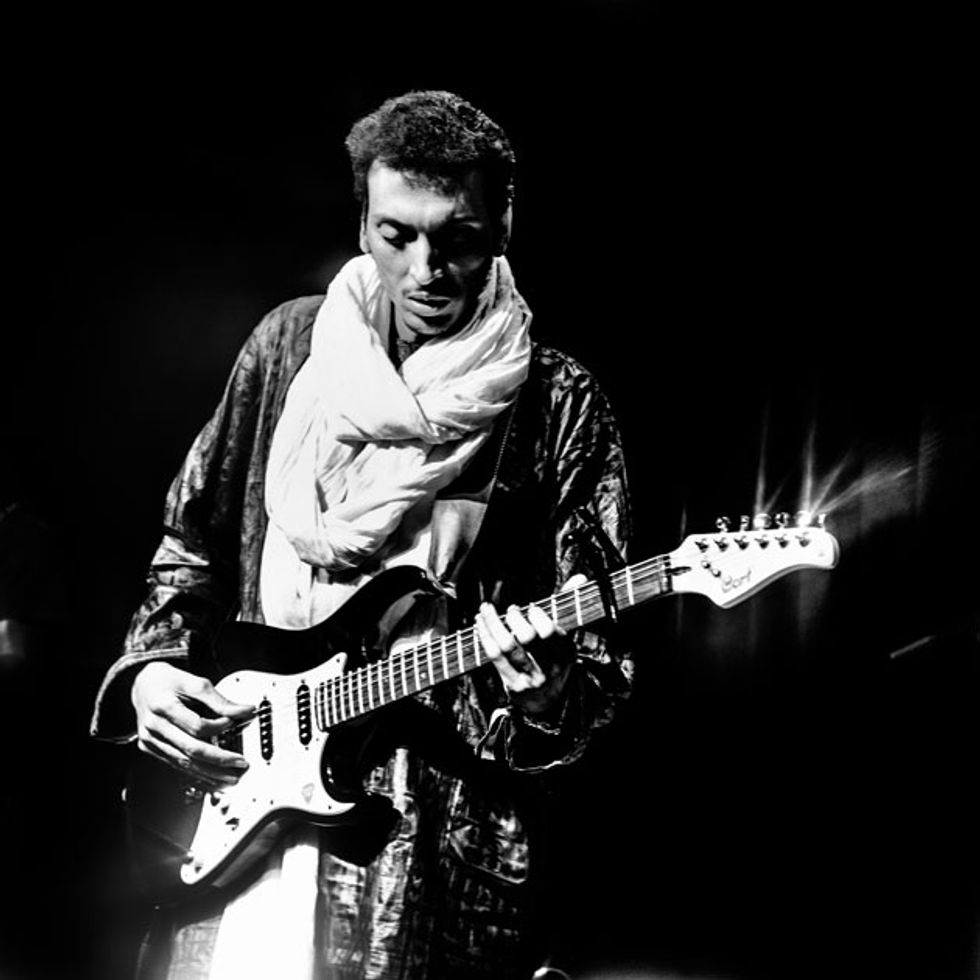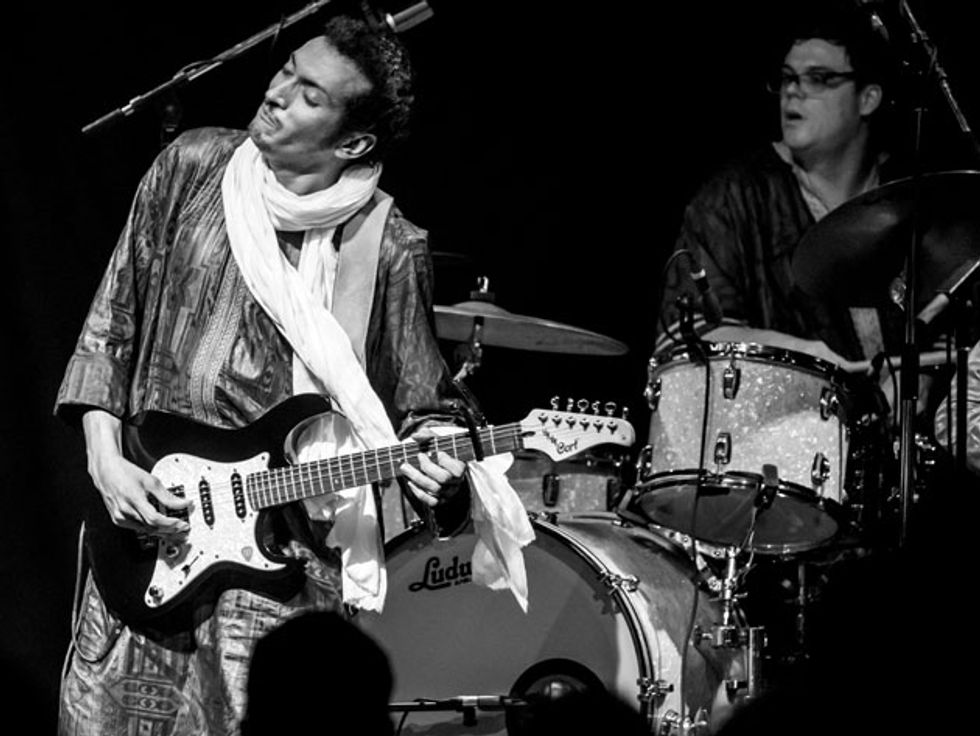They say that music is an international language, and this truism was recently confirmed when the guitarist Bombino decamped from his native Niger to Woodstock, New York, to make an album. Bombino speaks Tamasheq, Arabic, and French, but not English. He had to rely largely on musical gestures in recording the tracks on Azel, which was produced by Dave Longstreth of the avant-pop band Dirty Projectors.
Omara Moctar, aka Bombino, was born in 1980 in Agadez, Niger, to a Tuareg family. The Tuareg people are part of a nomadic Saharan culture with a history of staging armed uprisings against national governments. At the onset of the Tuareg rebellion that took place in Niger and Mali between 1990 and 1995, Bombino and his family fled to Algeria, and this is where his fascination with the guitar began.
Picking up a 6-string that visiting relatives left behind, Bombino learned to play by scrutinizing VHS and cassette tapes of rock guitarists like Mark Knopfler and Jimi Hendrix. At the same time, he studied formally with a master Tuareg guitarist, Haja Bebe, who gave him the nickname Bombino, meaning “the kid”—an acknowledgement of his precociousness.
It was only natural that, from his earliest days of playing, Bombino synthesized his own style from traditional Tuareg and Western blues and rock. The styles can sound quite similar, in large part due to their reliance on pentatonic scales and repetitive riffs, as well as a general earthiness.
Bombino toiled as a musician and herder until the late 1990s, when he retuned to his hometown to begin his musical career in earnest. His band, Group Bombino, played songs celebrating the heritage of the Tuareg people. But the Tuareg Rebellion of 2007–2009 ultimately dampened Bombino’s plans. The Tuareg government banned guitars, which it considered symbols of rebellion, and, horrifyingly, some of Bombino’s musical cohorts were executed, forcing him once again into exile.
In the middle of that conflict, filmmaker Ron Wyman heard a cassette of Bombino’s music and became enchanted. After a year-long search, in 2009 Wyman tracked down Bombino in Burkina Faso, in West Africa, resulting in a break for the guitarist. Not only did Wyman decide to feature Bombino in a documentary about the Tuareg, Agadez, the Music and the Rebellion, he strongly encouraged Bombino to make an album. After returning again to Agadez following the end of the rebellion, Bombino recorded Agadez, which debuted at No. 1 on the iTunes world music chart and captured the attention of Dan Auerbach of the Black Keys, among other prominent rock musicians.
Auerbach recorded Nomad, Bombino’s 2013 album, in his Nashville studio, adding a little Southern grit to the proceedings. And, similarly, Longstreth’s imprint can be seen in the clever arrangements and the subtly experimental aspects of Azel. But both producers respect the heart of Bombino’s music, which has so much to recommend itself to guitarists of all stripes—the athletic lines, kinetic grooves, and impressive choruses that Western ears immediately respond to.
Translated through his manager, Bombino told us about how he’s reconciled the worlds of traditional Tuareg music and rock, how his pieces are born as improvisations, and why he’ll never use a pick.

Factoid: Although anchored in Tuareg musical and lyric themes, Bombino’s new album, Azel, was cut in Woodstock, New York, by an international cast.
Can you briefly describe your musical history and how you came to take up the guitar?
I discovered the guitar when I was about 10 or 11 years old and my older cousins would come by with their guitar. They would play it and I would watch for hours. It pulled me in and I became obsessed. Also, they would play cassettes and videos of rock stars like Jimi Hendrix and Santana, and this is how I discovered rock music. I decided at a young age that I would play the guitar as my job for the rest of my life.
Talk about the impact Mark Knopfler and other rock guitarists have had on your playing.
Well, first of all, guitarists like Mark Knopfler and Jimi and Santana showed me a freedom that was possible to achieve through music and, more specifically, on the guitar. I would watch videos of these guys as a child and my heart would fill with an excitement and a sense of freedom. All I knew was that I wanted to experience this feeling of freedom that I imagined they had. So I began practicing the guitar for hours and hours every day until I could mimic them very well and also developed my own style.
What have you taken from traditional Tuareg music?
From traditional Tuareg music, I have taken the base of all my music. The drum rhythms, the scales we use on the guitar, the clothes, the style of performance, the lyrics … all of this is based on traditional Tuareg music. Many of the songs I play are traditional Tuareg songs that I’ve adapted into my style, which usually means I’m playing them much faster than they are played traditionally.
Your articulations on the guitar are distinctly non-Western, and this is especially obvious on acoustic guitar tracks like “Igmayagh Dum (My Lover).” How did you develop your sense of articulation and phrasing?
This is not something I can tell you, as I do not know myself. All I know is that I play all the time and I play from the heart. My style is not my own; it is something I inherited from Tuareg traditional music and the great artists that came before me like [the band] Tinariwen and Haja Bebe. I learned this same style and mixed it with a Western rock style. But I don’t read music or understand music theory or anything like that, so I cannot talk to you about my style as if I were a professor of music.
Although drummer Corey Wilhelm does not speak French (or Arabic or Tamasheq, for that matter), Bombino explains, “He and I have developed our own kind of language, often without using words, and we understand each other.”
Photo by Willem Melssen
Have you always played without a pick, and how did this technique come about—what are the benefits of playing your music fingerstyle?
I’ve never played with a pick. This isn’t something that’s done where I’m from. We all play using just our fingers. Using a pick is like taking an instrument that has five strings—your hand—and turning it into an instrument that has only one—the pick. Especially in the traditional style it is important to play with the thumb on the low string while your other fingers are free to play the melody or a solo.
How would you describe the differences, if any, between the way you approach the electric and acoustic guitars?
In my style and the Tuareg style, the major difference between playing acoustic and electric is that with the acoustic you’re also playing the part of the bass, with the steady open low string playing on every beat. I don’t do this on the electric guitar. Also, I do more experimenting on the electric guitar and bring in more styles, like reggae and funk. I play in a more traditional style when I play the acoustic guitar.
The last few years have been a whirlwind of activity for you. How do you feel your music has evolved during this time?
Quite simply, I think that with more and more experience playing together, my band and I are able to make more elaborate compositions and arrangements together. We’ve become like a family on the road these past two years, and now when we’re onstage we can play like we’re one person with eight arms. This, of course, makes the music more advanced.
What was it like to work with Dave Longstreth on the new album, and how did it feel to work in Woodstock?
Woodstock is a beautiful place—very green and relaxed. It’s the opposite of New York City. For us, it was a perfect place to record, because we could really feel comfortable and free from distractions, and the music was able to simply pour out naturally. Applehead is a great, great studio—very cool guys run that place.
Working with Dave was a great experience. Dave is a very cool and relaxed guy. He was not dominant as a producer. Instead, he would be patient and wait for us to do something and then he would give his opinion or a little push in one direction or another. With Dave, the music was able to be natural and pure, and he would add a little color or shape here or there.
What, if any, barriers do you experience when working with English-speaking musicians, and are there any unexpected benefits from not speaking the same language?
My drummer, Corey Wilhelm, who has played with me for three years, does not speak French. He and I have developed our own kind of language, often without using words, and we understand each other without any problem. In a certain sense, it can be a good thing to not speak the same language as someone you’re playing with, as you’re then forced to focus on the language of music that you’re speaking to each other.
Bombino's Gear
GuitarsCort KX-Custom electric
Cort Earth300VF acoustic
Amps
Fender Deluxe Reverb reissue
Effects
Boss ME-25 Guitar Multiple Effects unit
MI Audio Super Blues Pro overdrive
Strings and Picks
Assorted D’Addarios (.010 gauge sets on electric, .012s on acoustic)
The pieces on Azel sound fresh and spontaneous. Can you describe your compositional process? Do your tunes evolve from improvisations?
Yes, this is how I compose new music—through improvisation. Usually I’ll just be messing around and I’ll play something by accident that I like, so I’ll play it again and again until it develops into a riff that I can use as the foundation of a new song. Then I just build a song little by little from there.
A reggae influence has crept into your music—especially apparent on tracks like “Iyat Ninhay/Jaguar (A Great Desert I Saw)” and “Timtar (Memories).” How did this come about?
It’s something I began experimenting with in my live shows maybe three years ago and it has slowly become a regular part of my concerts. I like to sometimes break songs down with a reggae rhythm as a way of changing the energy and the pace of the song. In my experience, audiences always respond well to this. They like to hear something different and then return to the main rhythm. So this experimentation with Tuareg music and reggae music happened very naturally onstage and then, before I even realized it, I had adapted some songs completely into a “Tuareggae” style.
What was it like for you to incorporate Western vocal harmonies on Azel, like on “Akhar Zaman (This Moment)”?
Well, for me it wasn’t hard, because I was just singing the normal melody, but for Koutana [Abdoulahi Mohamed Van Loon], my backup singer for the album, this was a very difficult thing to do. We Tuareg are not used to singing like this. In fact, I believe this is the first time harmonies like this are used in Tuareg music. It took some hours of Dave and Koutana working together to get him to sing the harmonies that Dave had in his head.
YouTube It
This view of Bombino recording “Inar” for his new Azel album provides a spotlight on his fretboard technique. He plays with a freewheeling subjectivity that comes from absolute intimacy with his guitar. And note his right hand: He mostly uses his thumb and forefinger for his fleet picking, while his other fingers provide an anchor.
Talk about what it’s like to be Tuareg today and how this informs your music.
Being Tuareg today, there are good and bad things, like there would be for anyone. The Tuareg, for the most part, are not wealthy people or people with great political influence. But we are a people with a very strong culture and a pride in our identity and our history. To be a Tuareg means you are a person of the desert—the desert is at the center of our world. It is the inspiration for our customs and for our music. In this moment there are serious conflicts happening in our desert, just as there have been for centuries, but at the same time the Tuareg are gaining a new level of respect politically in Niger and culturally around the world. I’m simply trying to contribute to this positive change for the Tuareg people.













![Rig Rundown: Russian Circles’ Mike Sullivan [2025]](https://www.premierguitar.com/media-library/youtube.jpg?id=62303631&width=1245&height=700&quality=70&coordinates=0%2C0%2C0%2C0)












![Rig Rundown: AFI [2025]](https://www.premierguitar.com/media-library/youtube.jpg?id=62064741&width=1245&height=700&quality=70&coordinates=0%2C0%2C0%2C0)




















 Zach loves his Sovtek Mig 60 head, which he plays through a cab he built himself at a pipe-organ shop in Denver. Every glue joint is lined with thin leather for maximum air tightness, and it’s stocked with Celestion G12M Greenback speakers.
Zach loves his Sovtek Mig 60 head, which he plays through a cab he built himself at a pipe-organ shop in Denver. Every glue joint is lined with thin leather for maximum air tightness, and it’s stocked with Celestion G12M Greenback speakers.











